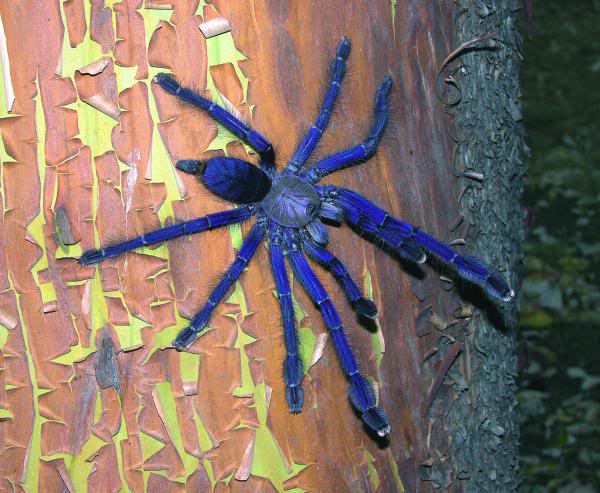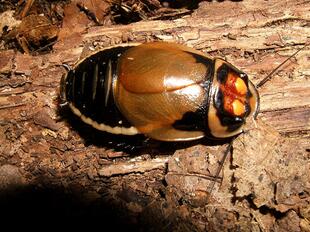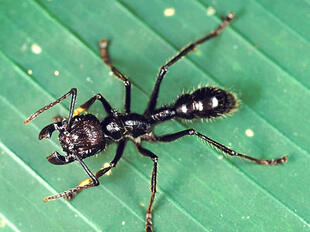
Lampropelma violaceopes (Lampropelma violaceopes)
Phylum —arthropoda
Class —arachnida
Order —araneae
Family — theraphosidae
Genus – lampropelma
Appearance
Lampropelmaviolaceopes is a large and particular colorful arboreal tarantula from the subfamily Ornithoctoninae. With its vibrant royal purple colors and long red hairs and the trademark tiger stripes on the abdomen it's a jewel in any collection.
There is a distinct difference between the two sexes as the male is olive green with faint yellow leg striation. Before sexual maturity both sexes will be a purplish-brown coloration. Subadult males however do tend to have a more fuzzy yellow setation. The deep royal purple will first be apparent with sexual maturity in the female and become increasingly deeper with each molt.
This is a very large spider with a leg span of 25 cm. and a carapace length above 3 cm.
Habitat
It lives in Malaysia and Singapore.
Behavior
In the wild, Lampropelmaviolaceopes lives mainly in woodlands and most often digs burrows, while young individuals prefer to live in the roots of trees and their voids.
The character of Lampropelmaviolaceopes is not easy: at the slightest danger it tries to hide in a hole or hide behind trees. If there is no way back, then he stands in his characteristic stance and tries to bite. The bite is quite dangerous for small animals, actually fatal. In the contact with humans it can only cause painful sensations and an allergic reaction.
Diet
Diet consists primarily of large beetles, cockroaches, large crickets, mantids, and other large arthropods. Occasionally, young mice, birds and other small vertebrates are taken. During feeding, the abdomen (opisthosoma) will often increase its size two-fold.
Reproduction
Best time for mating is in late summer/fall. It is common that the female eat or destroy the male after mating and this is usually a sign of a successful mating. The egg sac will hatch after 2-3 months and contains between 100-150 spiderlings.
In captivity
The females can live up to 14 years while the males live on average of five.
Due to their fondness of tree climbing; an enclosure that is taller than it is wide is needed. This is an exceptionally large tarantula so a very large enclosure is needed. A very secure lid is needed as these spiders have a skill for escaping.
Should be offered a hideaway consisting of a hollow log or cork bark tube fitted with an entrance hole. Also important is to fill the hideaway approximately halfway up with loose substrate, which the spider will incorporate with silk to make a snug home. The surrounding substrate should be 5-10 cm. deep and should be kept moist. Day temperatures should be in the range of 25-28 Celsius degrees with a drop to 20-22 at night. The annual climatic fluctuations follow that of Singapore.
The humidity levels need to be kept well around the 70% mark. Using a spray bottle to spray mists of water in the enclosure should help with humidity.
Tarantulas are not partial to light, so heat lighting is not recommended, though if necessary a red bulb should be used. However the owner should be prepared to keep a closer eye on the humidity levels.
Recommended feeding includes four to six live crickets every few weeks. Gut loading, or providing prey with vitamins and other nutrients, provides tarantulas with a healthy meal. Uneaten prey should be removed after one day. Fasting, or not eating, for days or weeks at a time is sometimes an indication of an upcoming moult. A water dish should be supplied and the water changed regularly to prevent harmful bacterial growth.
Caution should be taken, as Lampropelmaviolaceopesare a relatively aggressive species and tend to bite as the first line of defense.
 Russian
Russian
 English
English
























